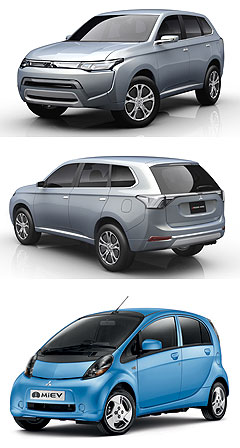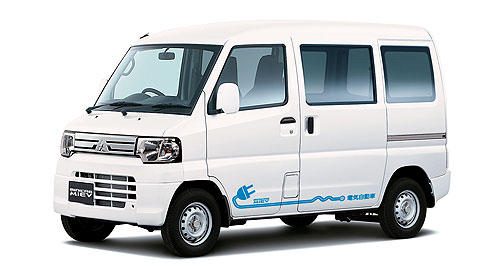Future models - Mitsubishi - Minicab-MiEVMitsubishi Oz eyes Minicab electric vanVan_e: Mitsubishi's Minicab-MiEV is under consideration for Australia. Load-lugging Mitsubishi i-MiEV likely to pioneer mini EV van market here24 Nov 2011 A TINY Mitsubishi all-electric delivery van is set to do for commercial vehicles what the pioneering i-MiEV city runabout did for passenger cars. Revealed in Japan ahead of its showroom rollout there next month, the Mitsubishi Minicab-MiEV is also a chance for Australia, where it would be aimed at the big-city delivery vehicle market from about 2013. Although it is not confirmed for local launch, Mitsubishi Motors Australia Ltd (MMAL) head of corporate communications Lenore Fletcher told GoAuto today that the Australian branch was interested in the little e-van, which would be up to 18 months away from Australian delivery. “Since we have had such a strong response to i-MiEV, we are interested in all electric or hybrid vehicles that are offered,” she said. Mitsubishi this week announced that it is also developing a plan to produce a version of the Minicab-MiEV for Suzuki in Japan from February, as part of its drive to reduce EV production costs by increasing economies of scale, but the Suzuki-badged electric van is unlikely to ever be sold in Australia. The Minicab-MiEV is believed to be one of eight full-EVs mooted by Mitsubishi, starting with the i-MiEV and continuing with plug-in versions of most of Mitsubishi’s core models. Just as the i-MiEV was based on a standard-petrol powered Mitsubishi mini-car – kei car in Japanese-speak – the new EV van is based on the current Minicab CD Van that plies its trade on the confined streets of Tokyo and other big Japanese cities.  Left: Mitsubishi PX-MiEV. Below: i-MiEV. Left: Mitsubishi PX-MiEV. Below: i-MiEV.The tiny rear-mounted 660cc petrol engine makes way for an equally small electric motor producing 30kW – the same as the entry-level i-MiEV available in Japan since July. Only the original, gruntier 49kW motor is offered in Australia’s i-MiEV. However, the van gets more torque, at 190Nm, versus i-MiEV’s 180Nm, as suits its purpose as a little load-lugger. Mitsubishi said the electric motor is the same Y4F1 unit as used in the i-MiEV, but reconfigured for maximum off-the-line torque and “gutsy performance even when fully loaded”. For Japan, the van will come with a choice of lithium-ion battery packs – an entry level 10.5kWh version good for a cruising range of about 100km, and a more expensive 16kWh premium model with a range of up to 150km – the same as the i-MiEV. The smaller battery pack can be charged in 4.5 hours on a 200-volt, 15amp connection, while the bigger version takes seven hours for a full charge from empty. An 80 per cent top-up on a high-voltage fast-charger is said to take just 35 minutes. Like the i-MiEV, the single electric motor drives the rear wheels of the Minicab-MiEV, which weighs just one tonne, batteries included. The batteries are stacked under the floor of the cabin, with the other electrical components such as the inverter under the cargo compartment. Mitsubishi quotes a payload capacity of 350kg with two occupants on board, which it says is the same as the petrol version. A four-seat model is also available as an alternative, with the cargo capacity dropping to 200kg. Mitsubishi says the zero-exhaust-emissions van will be handy for carrying perishable goods such as foodstuffs and flowers, and operating in sensitive areas – such as wholesale food markets – where petrol fumes are not appreciated. The company also most likely has one eye on a move by many of the world’s largest cities to phase out all internal combustion engine vehicles in downtown areas. In Japan, the base 100km Minicab-MiEV will have a list price of 2.4 million yen ($A31,884), but that reduces to just 1.7 million yen ($A22,988) when government EV subsidies are taken into account. The 150km version will be offered with a list price of 2.97 million yen ($A39,470), or two million yen ($A26,842) with subsidies. In Australia, where there are no subisidies, the i-MiEV is offered at $48,800 (plus on-road costs). Mitsubishi said it plans to sell 4000 Minicab-MiEVs in Japan in the remainder of the Japanese financial year, ending March 31. So far, the company has sold more than 17,000 i-MiEVs worldwide, including rebadged models for technical partners Peugeot and Citroen. If the Minicab-MiEV does make it to Australia, it might not be the only electric-powered delivery van on offer, as Nissan Australia is considering an all-electric version of the new NV200 van. The more conventional NV200 is bigger than the Mitsubishi van, and will operate in a different segment. The Nissan van is expected to become Nissan’s second all-electric vehicle on the Australian market after the five-door Leaf hatchback that is scheduled to plug into Australia next year. The Minicab-MiEV is not the only electric action happening at Mitsubishi this year, with the impending unveiling of the plug-in hybrid PX-MiEV II concept scheduled for the Tokyo motor show next week. The wagon is believed to be based on the 2013 Mitsubishi Outlander compact SUV, with the hybrid version boasting a claimed 50km driving range on battery power via dual electric motors, before a 2.0-litre four-cylinder engine kicks in.  Read more |
Click to shareMitsubishi modelsResearch Mitsubishi Motor industry news |

















Facebook Twitter Instagram